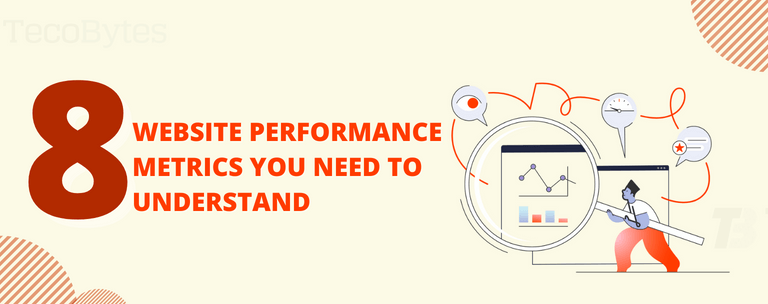
8 Website Performance Metrics You Need to Understand
How well does your website performance? How hard does it work for your company? Do you know?
Tracking website efficiency data gives you insight into how people interact with your different pages
Website Traffic is only the time and money needed to construct and manage a site. You can tell whether someone is taking the course you have pre-mapped for them by observing their behaviors and actions. If not, you may modify and improve your site to guide visitors toward the converts you want.
Here we have eight types of website performance metrics you should look at on a monthly basis:
- Website traffic
- Technical SEO health
- Site Authority Score
- Visibility Index
- Behavior analytics and user feedback
- Video plays and watched percentage
- Leads conversion
- Completion of Goals
1. Website traffic

Website traffic
Generally, Website traffic is about the users who come to your site. You must track the volume and quality of traffic, as well as what people are doing on your site. Understanding your traffic is essential because many eyeballs on-site mean potential sales. Each site visit is an opportunity to make a good impression and help people on their journey to solve their problems with your business as their guide. Here are some important site traffic metrics to be aware of.
Times: Google defines a session as “a group of users’ interactions with your website that takes place within a given time period.” A single session can contain multiple page views, events, and e-commerce activities.
As you process session data, ask yourself:
- Are the site sessions going up or down?
- Are there any marketing efforts (or lack thereof) in which you can combine styles in it?
- Are there any seasonal features that could be refreshing trends?
Channel, source, and content: Channels are large buckets out of your site traffic (direct, live, social, email, forwarding, paid, displayed, and other advertising). Source and medium drill down in detail. For example, within your paid traffic channel, you can have facebook.com as a source and pay by click (PPC) as a means of communication.
Knowing where your traffic is coming from helps to explore factors that affect site performance, such as SEO performance and not getting the natural traffic you want? Make sure your site and blog content are set up.
New guests compared to returnees: New guests are ready to feed the panel, but returning guests? They jump a little, look at more pages per session, have longer periods, and translate at a higher rate.
If you do not increase the number of returning visitors, you have a content problem. Your content needs to be published in high quality for people to keep coming back to the site.
Landing Pages: These pages are the logs for your website from specific sources. Looking at what pages people come to from live sources tells you how good (or bad) your SEO is. Landing pages from email sources provide an indication of what your subscribers are interested in. Do people go where you direct them?
Page time: Looking at the time spent on certain pages can tell you whether users are reading the copy you have written, engaging with dynamic content, watching videos, and having a good experience on the site. The time at the bottom of the page tells you that you are missing out and need to fill it out.
Pages per visit: Many pages per visit mean more interest, which means higher chances of conversion.
Jump level: Different types of pages should have different jump levels. For example, your Contact Us page may have a higher jump rate because people often submit a contact form and leave your site.
But, in general, Semrush notes that the jump rate of 56% to 70% is considered high (depending on which page is right for you), and the jump rate of 41% to 55% is average.
2. Technical SEO health
When we speak about SEO, it is not uncommon for marketers to think that it means referring to having a blog post optimized for search engines. But tech SEO is a big and ugly beast. It’s important to wrap your arms around it because if your professional SEO is healthy, high-quality search engines will give your site a higher ranking, and your site will be better. Include:
Title tags, meta descriptions, and unique image text: All of these web pages help search engines understand what a page is about.
Background Links: Internal links were created when another site linked to yours. More on this later.
Structured Data: The default format for marking information on a page so that search engines better understand what it is about.
Crawling: Search engines search for content online and look for the code/content they find in each URL.
Indexing: Search engines that store information that they retrieve during the search. If your pages are not indexed, they will not be listed on search engine results pages.
Offer: When bots use your site code and scan your content to understand the structure of your site. Reviews determine how your site is rated compared to others.
Mobile: How well your site is set up to be used on mobile devices is an important factor in user experience.
Site layout: This includes navigation, internal links, and URL structure. The construction of site information should be clear to users and search engines.
Status codes: When you visit a site, your browser sends a request to the server, and the server responds with a code. 1XX, 2XX and 3XX (redirect) correct codes. 4XX (pages not found) and 5XX (server) errors can cause problems and need to be fixed.
Page Speed: How fast the content of your site loads — faster, of course. Free tools, like Google PageSpeed Insights, will give your site points and give you opportunities to improve.
Example for PageSpeed Insights
If it sounds like a lot to wrap your head around, that’s for sure. Fortunately, there are tools out there, such as the Screaming Frog and Semrush, that marketers can use to test the SEO life of their site.
An example of Semrush Site Audit
Some adjustments, such as making sure that each page has a different title tag and meta description, are easy enough for a marketing professional to manage. Others, such as DNS troubleshooting issues, may need developmental help.
If your site’s health is improved, your site will be better off with search engine results. That’s why it’s important to make time, even if it’s just five hours a month, to review the technical SEO of your site and solve as many problems as possible.
3. Site Authority Score
Site Authority or Domain Authority points out how well a site will rank according to search engine rankings. Semrush describes the Authority Score as “our integrated domain that measures the overall quality of the website. The higher the score, the more likely it is to get a domain name or backlinks from a web page.
Semrush uses live search data, website traffic data, and backlink data to understand the levels of popular and trusted domains.
It also uses backlink data to determine whether finding links can increase site authority or decrease it.
You can use the Authority Score to judge how well your efforts to build a link pay off. Having a ton of internal links is not enough – the links should be of good quality to have a positive impact on the outcome of your site. You can also look at what your competitors are doing to see if you need to grow your game.
Your Site Administrator School may also be affected by toxic backlinks, which are internal links from unreliable sites. Checking for backlinks on a daily basis will ensure that your site’s Authority Score is not compromised.
4. Visibility Index
Semrush’s Visibility index tells you how often your site is available online: 100 results for any of these keywords, and 100 percent visibility means the domain ranks first in the SERP for all these keywords.
Increasing visibility in search engine results gives you a better chance of getting new eyes on your site. If you were removing your tail from SEO or a PPC campaign, visibility percentages are a great way to measure performance.
5. User feedback and behavior data
Behavior analysis tools, such as Hotjar, Lucky Orange, and Crazy Egg collect data based on user interaction with your website. This is very important because, although Google Analytics can present you with a lot of data about how people use your site, the picture is incomplete without knowing why users are doing what they are doing.
For example, you may see that the jump rate is high on a particular page. Behavioral analysis tools can fill gaps. Each tool has its own features, but it has some really cool features.
Heatmaps help you understand what users are doing on your site. You can view scrolls, movements, and clicks. Example of a heat map:
A map like this one can show you what users are most interested in, what they are ignoring, what they do not see, and what they think clicks are missing. Recording removes speculation on how people use your site. You can spend a lot of time logging in to view site visits.
Are the user-defined ways in which you develop your website really those that people actually do? Do visitors click the page, scroll down, scroll up, pause for a moment or two, try a different page, and bounce? Are they engaging with the dynamics you have added to the site, or are you ignoring them?
Items separate clusters into buckets and line buckets with thunder. Instead of showing the correct interaction of clicks (e.g., all random clicks in the blank white space), it will tell you which links and buttons are most often clicked. This is great for deciding where people want to go next when they are on a particular page.
Regularly monitoring user interaction gives you a better understanding of how people use your website. Would you not make an update if you knew what people were looking for?
6. Video plays and watched percentage
Producing high-quality website videos is not cheap. This is not about the iPhone videos you posted on Instagram. It’s about your product or service videos that do a great marketing job. You wrote texts, took time out of your routine to practice and make a film, made your teeth whiter, ironed your clothes for the first time in a year, and rented a production studio.
Your video capture field needs to provide statistics in the same way as your CMS does. Tools like Vidyard can provide that data. In the statistics dashboards, you can see: A number of people watching your videos.
What if the three pages they visited all had videos in them, and the site visitor spent more than 45 minutes watching a webinar, customer testimonials, and product demo? Considering the video time, the quality of that visit is very high, and that prospect is very important. That’s why video statistics are so important in understanding web performance overall.
7. Leads Conversion

CRM systems contain a database of your company’s subscribers, leadership opportunities, leaders, customers, and evangelists. Is your CRM connected to your website? I really hope so. If not, you are missing out on critical information about how (or not) your website effectively converts your contacts into evangelizers. Every month you should check where your contacts are coming from and how they interact with your site. Specifically, you should look at.
Leader number: How many leads does your site generate? For example, if you get a tone of directors but they are all dumb and inconsistent, that is a problem.
Leadership quality: You can judge this based on factors such as earning potential opportunities, the percentage of leaders who become converted customers, and the turnaround time.
Source lead: Where do your guides come from? Do you get organic traffic from blog posts you write, but traffic does not change? You will want to give readers the opportunity to dig deeper into your content, as the CTA images in your posts highlight high-value related downloads.
Leading conversion rate: If the content conversion rate is low, you will want to find ways to adjust it. If the conversion rate is high, you will want to drive additional traffic to it. You can also go back from your customer’s records to see how much and what kind of site content they shared on their customer journey. You may see patterns appear. For example, most of your customers can view at least 20 pages of a site before purchasing.
Cost Acquisition Cost (CAC): Each customer comes with a price, whether you are investing in ads or the time you produce a webinar. If you spend $ 150,000 on $ 20,000 in advertising, you will want to adjust your strategies.
Earnings: This is usually based on a recurring monthly income (MRR) or a customer cost (LTV). These metrics will help you understand how important your middle income is in relation to what you spend on shopping. Who, in particular, is watching them? What percentage of videos (how long) they have watched?
8. Completion of Goals
Google Analytics, you can set goals that monitor broad actions, such as spending five or more minutes on your site, viewing five or more pages on your site, clicking a link on a partner page, or clicking the “Add to Cart” CTA. Some, but not all, of these actions can be tracked in your default marketing application, so using Google Analytics is a great way to compile your data.
Site authorities, visibility, traffic, SEO SEO, video statistics, and behavioral analysis tell you what people can and do on your site. Policy termination measures whether site visitors are doing what you need them to do or not. Simply put, does your site meet your business objectives or not?
Lastly, Your website is intended to be your most dedicated reseller. You should review its performance, as you would in any other activity, to see if it fits your company’s mission.




